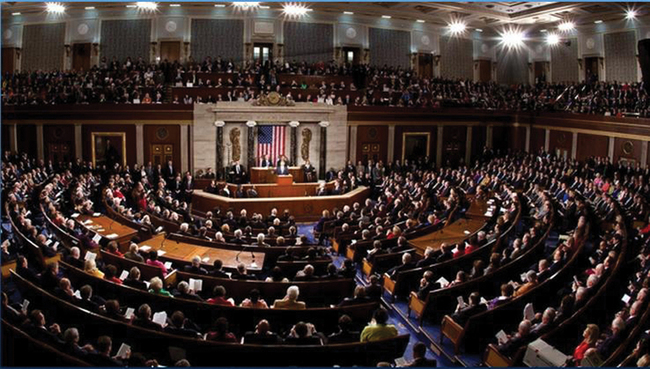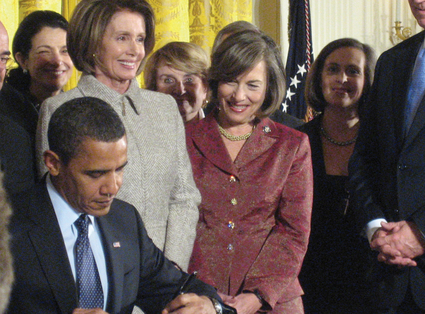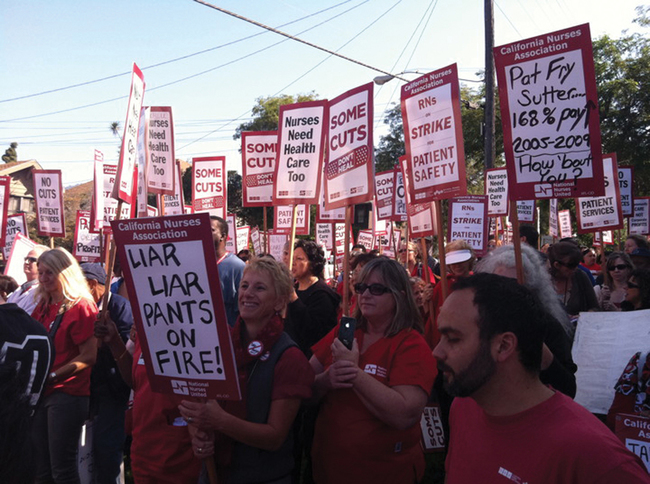After studying this chapter, students will be able to: • Differentiate between politics and policy. • Explain why professions have associations. • Demonstrate an understanding of the complex role that associations play in the profession and in society. • Recognize the opportunities that associations offer to increase the leadership capacity of nursing students and registered nurses. • Explain the concept of personalizing the political process. • Describe the debate in nursing regarding unionization. • Cite examples of sources of both personal and professional power. • Describe how nurses can become involved in politics and policy development at the levels of citizen, activist, and politician. • Explain how organized nursing is involved in political activities designed to strengthen professional nursing and influence health policy. Never before has the national policy-making stage seemed so close at hand to the American public. National media networks and 24-hour cable news coverage have brought life “inside the Beltway” of Washington, D.C. into American living rooms and under scrutiny. Interest and involvement of American citizens in governmental processes and accountability are good for democracy. Events on the national and even the world stage seem very close at hand (Figure 15-1). Chapter opening photo from istockphoto.com. Several chapters of this book cover material that is heavily influenced by government. The content of Chapter 1, the current status of nursing, will be the content of a future edition’s Chapter 2, the history and social contexts of nursing. The content of both of these chapters reflects policy and politics that affect who nurses are and what we do. Chapter 4 is directly concerned with policy that affects practice. Governmental regulation through licensure is an issue, but the influence of professional organizations to set standards and affect nurse practice acts demonstrates the two-way process that is required to keep nursing relevant and up-to-date within the health care arena. The focus on ethics in Chapter 5 describes issues of justice and autonomy, foundational principles in American jurisprudence, which shape how we understand and resolve ethical dilemmas. Issues of nursing education (Chapter 7) are directly shaped by governmental regulation to ensure that schools of nursing produce graduates that can be entrusted to provide safe care. In Chapter 11, nursing research is shown to be heavily dependent on the financing of the National Institutes of Health’s National Institute for Nursing Research and other centers and institutes funded with federal dollars. Research is key to the development of the knowledge base of nursing, which in turn protects its status as a profession and an academic discipline and its influence in both academic and policy arenas. The previous chapter, Chapter 14, addressed the complex issues surrounding how health care is delivered and financed. This is a heavily regulated endeavor with incredibly intricate implications affecting how and where nurses practice. This completes the circle, in a sense, drawing you back to Chapter 1, the current status of nursing, and where we are going. 1. The science of government; that part of ethics which has to do with the regulation and government of a nation or state, the preservation of its safety, peace, and prosperity, the defense of its existence and rights against foreign control or conquest, the augmentation of its strength and resources, and the protection of its citizens in their rights, with the preservation and improvement of their morals. 2. The management of a political party; the conduct and contests of parties with reference to political measures or the administration of public affairs; the advancement of candidates to office; in a bad sense, artful or dishonest management to secure the success of political candidates or parties; political trickery. http://dictionary.reference.com/browse/politics, 2009 Policy, on the other hand refers to the following: http://dictionary.reference.com/browse/policy, 2009 Policy is shaped to a great degree by those who are successful in the political arena (the second definition). These are the elected officials who describe their agenda before the election to receive support, endorsements, and, ultimately, enough votes to be elected into office. For instance, during the 2008 presidential campaign, the pros and cons of health care reform were discussed and debated at length, and as the nominee, Barack Obama took a stand in favor of health care reform. This was debated again in the 2012 campaign. That Obama embarked on a complex and wide-ranging effort to make health care more affordable should have been of no surprise to anyone who was paying attention to the 24-hour cable news outlets that both reported and argued the various merits of his health care campaign agenda throughout these campaigns. In other words, President Obama used politics as a process (the second definition) to achieve a goal of managing the government (first definition) so that he could influence change in health care policy with the expectation and hope of improving affordability. One of the first pieces of legislation signed by President Obama was the State Children’s Health Insurance Program (SCHIP) reauthorization legislation that extended health insurance coverage to 8 million children whose parents cannot afford health insurance coverage (Figure 15-2). In organizations, stakeholders are the members, the larger community served by the work of the organization, and other groups or individuals affected by those decisions. For example, Patients Out of Time, an organization started by a nurse, has worked for years to educate the public and health care professionals about the therapeutic use of cannabis and to advocate for the medicinal use of marijuana (www.medicalcannabis.com). Stakeholders for this organization are affected patients and families, health care providers, and those who make decisions about the laws and regulations about cannabis use. These include state and federal legislators, as well as the U.S. Food and Drug Administration (FDA), the Secretary of Health and Human Services (who oversees the policies of the FDA), and organizations such as the ANA and the American Public Health Association, both of which support the therapeutic use of cannabis/marijuana (ANA, 2008; American Public Health Association, 1995). Leaders in nursing, from Florence Nightingale to Lavinia Dock, saw and understood the connection between their work and the larger world in which policy decisions affected what they were able to do. Nightingale could not have been successful in the Crimea without the support of Sir Sidney Herbert, Secretary of War. Lavinia Dock joined with other nurses to found the ANA, pressure hospital administrators to improve working conditions for nurses, and galvanize support for nursing registration (Lewenson, 2007, p. 23). A recent example is Karen Daley, a modern nurse who went public with her needlestick injury from which she contracted human immunodeficiency virus (HIV) and hepatitis C infections (Daley, 2007). She went public to influence legislation requiring protective devices. In each instance, these leaders knew that nursing practice could be improved only through legislation, regulation, or unification to create a formidable national organization. Daley recognized the power in her story and the extent to which her experience could influence those with authority to make nursing practice safer. Her testimony before the House Committee on Education and the Workforce’s Subcommittee on Workforce Protection can be found at http://archives.republicans.edlabor.house.gov/archive/hearings/106th/wp/needlestick62200/daley.htm. Professionals create organizations to work collectively on issues that enhance their work and their involvement in communities, to ensure continued learning and competence, and to use political action to influence policy makers to support the mission of the organization. Professional organizations offer a supportive way to learn leadership skills, to test ideas, and to follow these ideas to completion. Nursing has a national organization open to all RNs, the ANA (www.nursingworld.org); a national student nurses organization, the National Student Nurses Association (NSNA, www.nsna.org); and many other specialty organizations developed around particular practice areas. Nursing organizations influence public policy in a variety of ways. The following section examines the role and function of organizations, explores why nurses do or do not join organizations, and discusses examples of collective action. Because organizations are often the catalyst for involvement in political action, we will also explore the broader area of political action in the public arena. Examples of special interest organizations include Sigma Theta Tau International (the Honor Society of Nursing), which one must be invited to join, and the American Association for the History of Nursing, which focuses on a particular area of study in nursing. Comprehensive and frequently updated lists of nursing organizations are available online at www.nurse.org/orgs.shtml. Founded in 1899, the ICN is the world’s first and widest-reaching international organization for health professionals. Operated by nurses for nurses, the ICN works to ensure quality nursing care for all, sound health policies globally, the advancement of nursing knowledge, the presence worldwide of a respected nursing profession, and a competent and satisfied nursing workforce. For additional details about the ICN’s activities in professional nursing practice, nursing regulation, and the socioeconomic welfare of nurses, visit the ICN home page (www.icn.ch). An organization’s activities reflect its mission statement. The mission statement is generated by the membership and defines the organization’s purpose and who is served by the organization. For instance, the ANA’s goals are “fostering high standards of nursing practice, promoting the rights of nurses in the workplace, projecting a positive and realistic view of nursing, and by lobbying the Congress and regulatory agencies on health care issues affecting nurses and the public” (www.nursingworld.org, 2012). These goals are reflected in their concise mission statement: Nurses advancing our profession to improve health for all (www.nursingworld.org, 2012). These goals and mission define the association’s areas of focus as practice standards, a code of ethical conduct, continuing education and conferences, and collective action around workplace issues. Nurses wonder whether they should join unions. Much of that depends on where they work. If seeking a staff position in an institution in which a nursing union already exists, a nurse may be required to join the union as a condition of employment. This is called a “closed shop,” meaning that management is required to bargain with the union, and union membership is required as a condition of employment. An “open shop” is one in which employees are not required to join but in which an individual’s contract will be dependent on what union and management have negotiated. Most nurses work in nonunion facilities. Some states are more “union friendly” than others. States in which labor unions flourish, such as in the Northeast, Northwest, and Midwest, have the vast majority of nursing unions. Smaller states, particularly in the Southeast (other than Florida) and Southwest, have few or no nurse unions. These are known as “right to work states.” Although unions have made numerous attempts to organize nurses in these states, the value system of the work culture is less supportive of union affiliation by nursing professionals. Figure 15-3 shows nurses protesting during a 1-day strike in California in September, 2011.
Political activism in nursing: Communities, organizations, government
![]() To enhance your understanding of this chapter, try the Student Exercises on the Evolve site at http://evolve. elsevier.com/Black/professional.
To enhance your understanding of this chapter, try the Student Exercises on the Evolve site at http://evolve. elsevier.com/Black/professional.
Policy and politics
Politics
Linking practice, policy, and politics
Professional organizations
Types of associations
Purpose and activities of organizations
Nurses and unions
![]()
Stay updated, free articles. Join our Telegram channel

Full access? Get Clinical Tree


Political activism in nursing: Communities, organizations, government
Get Clinical Tree app for offline access



